Psychophysical therapy and underlying neuroendocrine mechanisms for the rehabilitation of long COVID-19
- PMID: 37842301
- PMCID: PMC10570751
- DOI: 10.3389/fendo.2023.1120475
Psychophysical therapy and underlying neuroendocrine mechanisms for the rehabilitation of long COVID-19
Abstract
With the global epidemic and prevention of the COVID-19, long COVID-19 sequelae and its comprehensive prevention have attracted widespread attention. Long COVID-19 sequelae refer to that three months after acute COVID-19, the test of SARS-CoV-2 is negative, but some symptoms still exist, such as cough, prolonged dyspnea and fatigue, shortness of breath, palpitations and insomnia. Its pathological mechanism is related to direct viral damage, immunopathological response, endocrine and metabolism disorders. Although there are more effective methods for treating COVID-19, the treatment options available for patients with long COVID-19 remain quite limited. Psychophysical therapies, such as exercise, oxygen therapy, photobiomodulation, and meditation, have been attempted as treatment modalities for long COVID-19, which have the potential to promote recovery through immune regulation, antioxidant effects, and neuroendocrine regulation. Neuroendocrine regulation plays a significant role in repairing damage after viral infection, regulating immune homeostasis, and improving metabolic activity in patients with long COVID-19. This review uses oxytocin as an example to examine the neuroendocrine mechanisms involved in the psychophysical therapies of long COVID-19 syndrome and proposes a psychophysical strategy for the treatment of long COVID-19.
Keywords: hormone; long COVID-19; psychophysical therapies; rehabilitation; sequelae.
Copyright © 2023 Meng, Song, Churilov, Zhang and Wang.
Conflict of interest statement
The authors declare that the research was conducted in the absence of any commercial or financial relationships that could be construed as a potential conflict of interest.
Figures
References
-
- Osmanov IM, Spiridonova E, Bobkova P, Gamirova A, Shikhaleva A, Andreeva M, et al. . Risk factors for post-COVID-19 condition in previously hospitalised children using the ISARIC Global follow-up protocol: a prospective cohort study. Eur Respir J (2022) 59(2):2101341. doi: 10.1183/13993003.01341-2021 - DOI - PMC - PubMed
Publication types
MeSH terms
LinkOut - more resources
Full Text Sources
Medical
Miscellaneous


